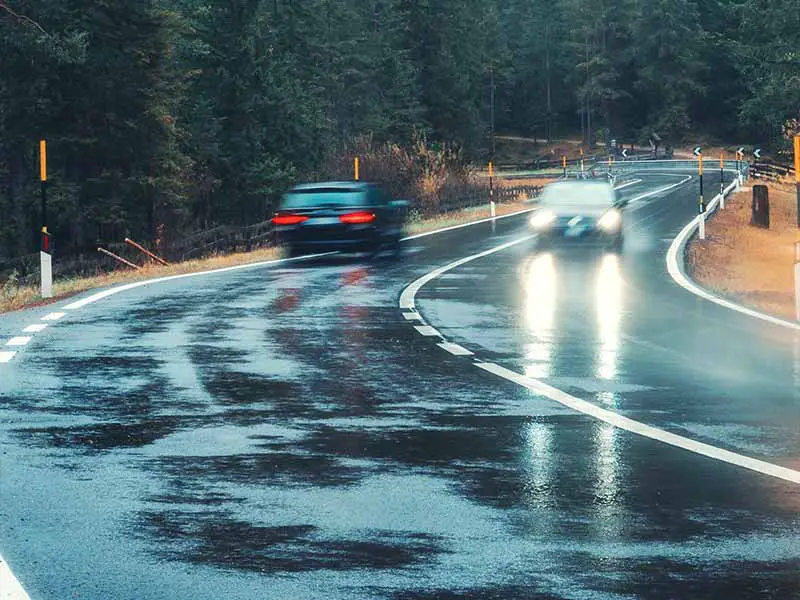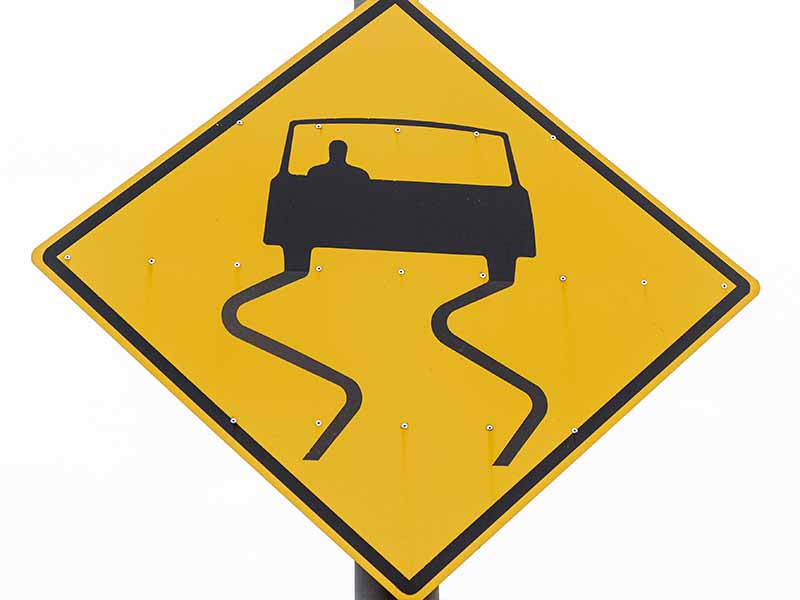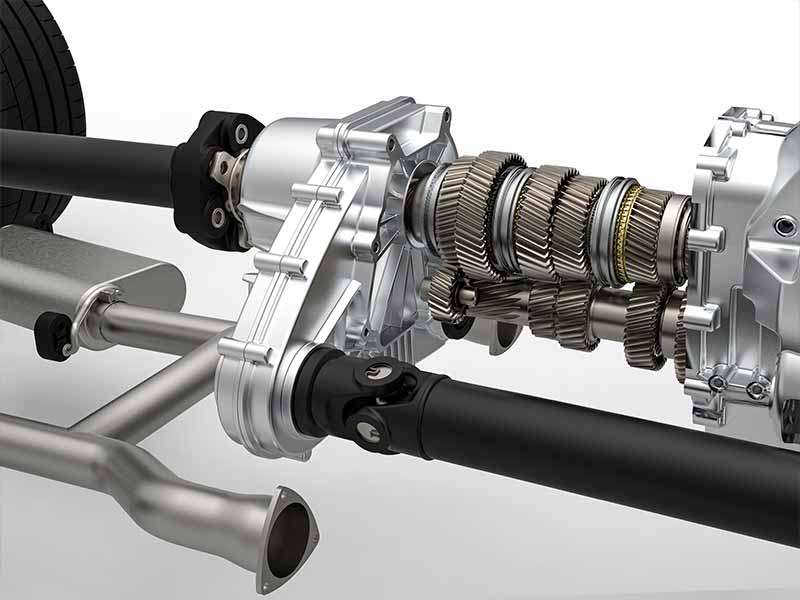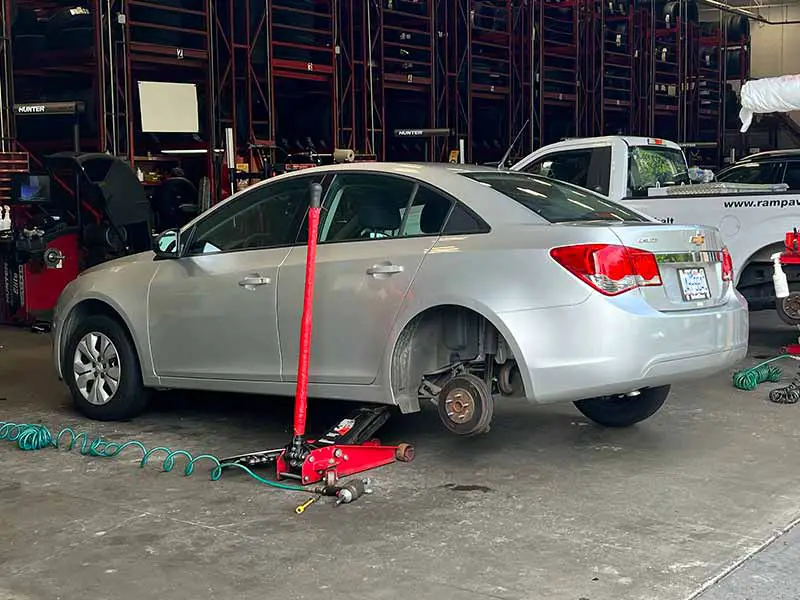Replacement tires are expensive and having to purchase more than one tire is something most of us would like to avoid if we can. Flat tires and other types of damage happen and it seems like a waste of money to pay for more than one tire.
There are times when it’s okay to replace just one tire, but for the majority of the time, we recommend purchasing two tires at a minimum when you need to buy new tires. We also recommend replacing all four tires if your tires are worn to less than 4/32″ of remaining tread.
Things get more complicated when you can’t get a replacement tire that’s the same model and brand to match your existing tire.
Replacing One Tire With A Different Brand
It’s not recommended to have a damaged tire replaced with just one tire with a different brand. The new tire will have different performance characteristics and likely a different rolling diameter.
These differences can cause traction control and anti-lock braking systems to struggle to maintain traction in adverse weather or emergency situations.
There are several reasons to purchase new tires in pairs or even in complete sets of four tires.
Let’s take a closer look
Different Tread Patterns On Front And Rear Tires
It’s recommended that you use the same tires at each corner of your car or truck. However, we understand that is not always possible due to budget or availability constraints.
If mixing different brand tires or tire types becomes unavoidable, then it is possible to mix tread patterns and tire brands, but it’s only recommended to do so as long as you fit a pair of identical tires on the same axle. This means installing a set of matching tires on the rear axle or to the front.

Different Tread Patterns On The Same Axle
Tread pattern plays a major role in the performance of each tire, and engineers focus on dry braking, wet braking, handling, irregular wear, and snow and ice traction when designing the tread pattern. Each thread pattern acts in a different way on the road and they deal with road conditions differently.
This is why mixing different tread patterns across the same axle is not permitted. The identical tread patterns and tire model must be fitted for a single axle, but you can use different tires on a separate axle, as long as they also match.
Nevertheless, tire experts recommend the same tires be mounted at each corner of your car. This will help ensure a consistent and dependable driving experience, without the risk of confusing traction control systems or antilock braking systems that the mixing tire brands and tread depths could bring.
Tires With Different Tread Depth
When two tires are manufactured by the same company and have the same tread pattern, they will have the same diameter and spin at the same rate when they’re new. As they wear down from driving, there might be a small difference in the rate of wear from one side to another, but it should be very minor. Front and rear tires might also wear at a slightly different rate from each other.
This difference in tread depth creates a difference in the rolling diameter of the tires, which means the tire with less tread depth will have to spin faster for the same distance due to a shorter rolling diameter.
The difference in speed between one side or end of your car to the other can put a lot of stress on the drivetrain. Since these differences are inevitable and accounted for by vehicle manufacturers. However, there’s still an issue when the differences become too much.
More significant differences occur if you replace just one tire and the existing tire is much more worn. Matching worn tires with new tires can lead to noticeable differences in rolling diameter and cause electronic stability programs to struggle to calculate traction adjustments correctly, causing unpredictable performance.
When you need to replace only one tire, you should only do so if the other tire on the same axle has 7/32″ of tread wear or more remaining and you can match the tire brand and tread pattern.
Measure the tread of all four tires and place the two tires that are the most worn on the front axle. You should also move the new tire and the tire with the most tread remaining to the rear axle.

Traction Control & Anti-Lock Brake Systems
The traction control and anti-lock brake systems work by measuring wheel speed. Since different size tires have different diameters, they also have different rates of spin. Smaller tires will spin faster than larger ones.
Even a ¼ inch difference in the rolling diameter of the tires side-to-side or front-to-back can make the system think that certain wheels are losing traction when they’re just spinning slower or faster than others.
So, if for example, the rear tires are taller and therefore spinning slower than the ones in the front (due to mismatched sizes or big differences in tread wear), the ABS and traction systems may consider the front wheels have lost traction because they are spinning faster than the ones in the back.
The systems will reduce engine power and even apply the brakes if it considers the wheels slipping (or spinning faster).
Drivetrain Damage From Mismatched Tires
Tires and their condition have an important role in the longevity of a vehicle. Mismatched tires can lead to drivetrain damage, which happens in different ways depending on the type of drive.
Tires with different amounts of wear aren’t likely to be the cause of actual damage, but they can cause traction problems.
Two tires of different brands or even the same brand with different tread designs can have more significant effects on drivetrain systems. When you replace just one tire with a different brand new tire it can have quite a big difference in rolling diameter and traction in different road conditions.
When these differences in performance and rolling diameter are great enough they can put a strain on different drivetrain parts depending on the drive axle and the amount of difference between the two tires.

Two-Wheel Drive
Mismatched tire sizes on 2WD will affect different drivetrain components and can cause damage. One particular area that can be affected is the differential assembly.
The differential allows different rates of speed of wheels from side-to-side during turns, therefore allowing the vehicle to be propelled evenly regardless of the rate of spin of each individual tire.
When your tires are the same size, the differential will only operate when there’s a difference in speed between the sides, such as when the car turns. And this is how it’s supposed to work.
However, with two different size tires, there is a difference in speed even when driving straight. This can potentially put a lot of extra wear and tear on the differential and lead to damage.
Four-Wheel/All-Wheel Drive
The same rule applies to 4WD and AWD vehicles. All four tires must be of the same size, brand, and tread depth. AWD vehicles drive all four tires at all times, and 4WD vehicles can use all four when selected by the driver or automatically applied when needed.
These vehicles may also have a center differential to handle differences from front to rear and conventional differentials between the driver’s and passenger’s side wheels as well. This makes tire size even more important.
Be sure to refer to your vehicle’s owner’s manual for recommendations on how to replace tires. Some manufacturers will recommend replacing two tires on the same axle or require all your tires to be replaced to ensure your all-wheel drive mechanicals and traction control systems function as designed.
How Tread Depth Affects Stopping Distance On Wet Roads
Tread depth is very important for wet weather grip. The tread of a tire allows water on the road to pass through the grooves. This design allows the tire to stay in contact with the road and maintain traction.
Minor wear on a new set of tires has little performance loss, considering the tires have been already broken in. However, the stopping distances between a new tire and one with 4/32” of tread remaining are generally 50% longer on wet roads when panic braking.
If you allow your tires to wear down to the legal minimum of 2/32”, the wet stopping distance is increased by another 50%. That means a completely worn tire will take twice the distance to come to a complete stop in wet road conditions, even with traction control and ABS activated.
When the tread is worn, it doesn’t provide a deep enough groove to allow the water to flow out from underneath the contact patch quickly enough. This condition causes hydroplaning, which is basically a loss of traction where the vehicle glides over a layer of water between the tires and the road. When a car hydroplanes, you cannot steer or brake until the tires regain traction.
Resources
Below are some links you may find helpful when learning about tires
Final Thoughts
In the end, purchasing two new tires is best for optimal performance when you need your tire most – in adverse weather and emergency situations.
Different brands will create differences in performance that can make traction control and antilock braking systems struggle to do their job as well as they could otherwise.
New tires are expensive, but they’re also one of the single most important parts of your car or truck. They are asked to do a lot and all of the other systems and parts of your vehicle depend on them.
Good luck and happy motoring.






